자연이 그리는 그림을 담다
풍경의 그림자들_ 마넬 에스클루사
풍경의 그림자들_ 마넬 에스클루사
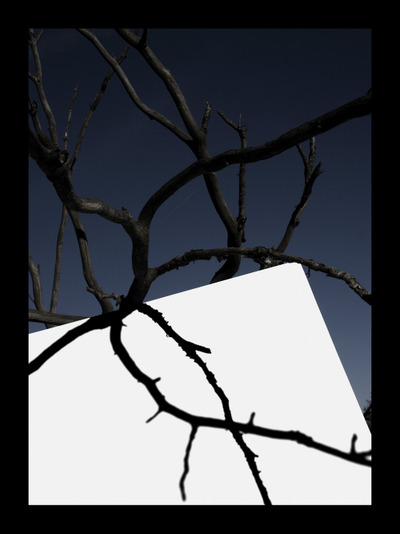
Como una Grafia, la Sombra, 2008

Sombra Dentro del Infinito, 2006
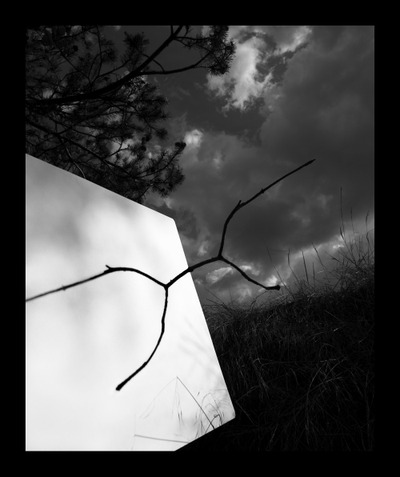
Sombra Acompasada, 2006
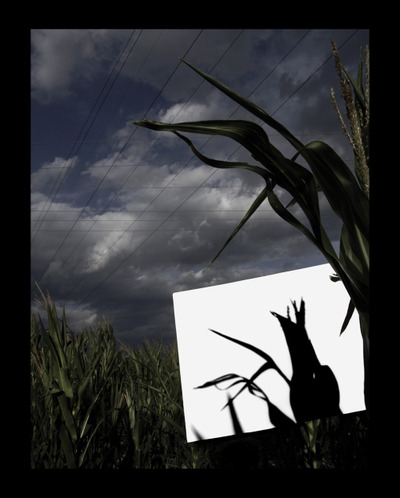
Como la Sombra que Levanta el Vuelo, 2006
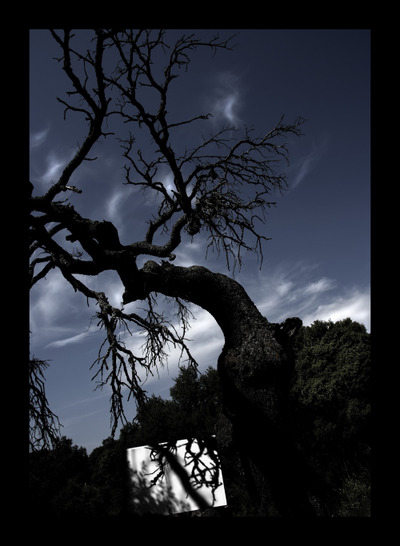
Sombra de Encina, 2006
마넬 에스클루사는 많은 스페인 작가 중에서도 개인적이면서도 뚜렷한 자신만의 도상을 가진 작가이다. 그는 2006년《풍경
의 그림자》시리즈 작업을 시작하여, 다른 작업들과 마찬가지로 자유롭게 꾸준히 작업을 이어 가고 있다. 사진가는 자신의 내면을 투사하여 도시이든 자연이든 모든 풍경을 정서적인 장면으로 전환할 수 있다. 이 때문에 사진가들은 종종 풍경을 은유로 사용하기도 한다. 마넬에스클루사의 경우, 이미지 안에서 하나의 움직임을 목격할 수 있다. 그가 사진에 담은 장소가 작가 자신과 자연, 그리고 사진 사이에 존재하는 관계들을 보여 주는 상징적인 장면으로 전환되는 것이다. 그리하여 그의 이미지들은 작가의 발상을 수용하고 형성하는 시각적이자 개념적인 구조를 보여 주게 된다. 《풍경의 그림자》는 마넬 에스클루사의 사진 작업에서의 중심 요소들의 일부가 집적된 작업이다. 《풍경의 그림자》는 그의 수많은 작업을 이끄는 가장 중요한 요소가 그림자임을 강조하여 보여 준다. 사진에서 마넬 에스클루사는 어둠의 파편이라고도 할 수 있는 그림자를 유연한 일종의 시각적 매개로 전환한다. 그리고 이를 통해 물적 세계를 그의 형이상학적 사고에 좀 더 가깝게 끌어 온다. 여기에서 마넬 에스클루사의 사진 작업의 근간을 이루는 요소들을 일부 확인할 수 있다. 사진의 고요하고 정적인 장면에는 미니멀리즘과 미묘한 젠 철학의 느낌이 엿보인다. 작가는 단순한 매개자로서만 존재하는 것처럼 보인다. 그는 개입을 절제하고 자연으로 하여금 그 짧은 한순간 존재의 흔적을 스스로 드러내도록 한다. 그럼에도, 그의 사진들은 표상이 부재하지도, 단순한 기록으로 그치지도 않는다. 그의 이미지들은 시적으로 확장된 빛의 흔적들이며, 보이지 않는 것을 시각화하는 사진의 힘을 드러낸다.《풍경의 그림자》를 통해 마넬 에스클루사는 자신의 현존이 아닌 자연 그 자체에서 우러나오는 세계의 이미지를 구축하고자 한다. 윌리엄 헨리 폭스 탈보트는 그가 제작한 세계 최초의 사진집인『자연의 연필』(1844)에서“자연은 스스로 자신을 그린다”라고 말했다. 마넬 에스클루사는《풍경의 그림자》로서 그의 주장에 헌사를 보낸다. 그의 이미지들은 사진이라는 매체의 태동에 대한 은유라고 할 수 있다.흰 종이 위에 나타나는 이미지들은 포토그램에 대한 오마주이자 은염의 감광 유제로 코팅된 종이들 위에 인공적인 빛을 가하여 이미지를 만들어 내는 연금술적인 행위에 대한 기억이다. 두 경우 모두 작가의 사진에 대한 열정을 보여 준다. 또한, 흰 종이 위에 나타나는 그림자는 벽 위에 생기는 인간 얼굴의 그림자를 기록하면서 이것이 상징적인 표현으로 변하였다고 하는 회화의 기원에 대한 코린트의 전설을 상기시키기도 한다. 마넬 에스클루사에게 자연은 빛으로 변화무쌍한 그림을 그리는 캔버스와 같다. 그는 풍경 한복판에 하얀 종이를 설치하고 사라지는 빛들이 그 위에 잠깐씩 남기는 그림자들의 몇몇 단편들을 선택할 뿐이다. 이를 통해 그는 보이지 않는 자연의 그림들을 눈앞에 드러내고 우리 앞에 존재할 수 있도록 한다. 마넬 에스클루사의 많은 작업은 그가 촬영하는 장소와의 깊은 상호 작용에서 우러나오는 결과물로서 존재한다. 이러한 이미지들을 창조하기 위해 작가는 자신을 고독과 침묵으로 둘러싼다. 그 안에서 자아성찰, 그리고 신비로우면서도 동시에 유희적인 작가와 자연과의 관계는 더욱 강화된다.
의 그림자》시리즈 작업을 시작하여, 다른 작업들과 마찬가지로 자유롭게 꾸준히 작업을 이어 가고 있다. 사진가는 자신의 내면을 투사하여 도시이든 자연이든 모든 풍경을 정서적인 장면으로 전환할 수 있다. 이 때문에 사진가들은 종종 풍경을 은유로 사용하기도 한다. 마넬에스클루사의 경우, 이미지 안에서 하나의 움직임을 목격할 수 있다. 그가 사진에 담은 장소가 작가 자신과 자연, 그리고 사진 사이에 존재하는 관계들을 보여 주는 상징적인 장면으로 전환되는 것이다. 그리하여 그의 이미지들은 작가의 발상을 수용하고 형성하는 시각적이자 개념적인 구조를 보여 주게 된다. 《풍경의 그림자》는 마넬 에스클루사의 사진 작업에서의 중심 요소들의 일부가 집적된 작업이다. 《풍경의 그림자》는 그의 수많은 작업을 이끄는 가장 중요한 요소가 그림자임을 강조하여 보여 준다. 사진에서 마넬 에스클루사는 어둠의 파편이라고도 할 수 있는 그림자를 유연한 일종의 시각적 매개로 전환한다. 그리고 이를 통해 물적 세계를 그의 형이상학적 사고에 좀 더 가깝게 끌어 온다. 여기에서 마넬 에스클루사의 사진 작업의 근간을 이루는 요소들을 일부 확인할 수 있다. 사진의 고요하고 정적인 장면에는 미니멀리즘과 미묘한 젠 철학의 느낌이 엿보인다. 작가는 단순한 매개자로서만 존재하는 것처럼 보인다. 그는 개입을 절제하고 자연으로 하여금 그 짧은 한순간 존재의 흔적을 스스로 드러내도록 한다. 그럼에도, 그의 사진들은 표상이 부재하지도, 단순한 기록으로 그치지도 않는다. 그의 이미지들은 시적으로 확장된 빛의 흔적들이며, 보이지 않는 것을 시각화하는 사진의 힘을 드러낸다.《풍경의 그림자》를 통해 마넬 에스클루사는 자신의 현존이 아닌 자연 그 자체에서 우러나오는 세계의 이미지를 구축하고자 한다. 윌리엄 헨리 폭스 탈보트는 그가 제작한 세계 최초의 사진집인『자연의 연필』(1844)에서“자연은 스스로 자신을 그린다”라고 말했다. 마넬 에스클루사는《풍경의 그림자》로서 그의 주장에 헌사를 보낸다. 그의 이미지들은 사진이라는 매체의 태동에 대한 은유라고 할 수 있다.흰 종이 위에 나타나는 이미지들은 포토그램에 대한 오마주이자 은염의 감광 유제로 코팅된 종이들 위에 인공적인 빛을 가하여 이미지를 만들어 내는 연금술적인 행위에 대한 기억이다. 두 경우 모두 작가의 사진에 대한 열정을 보여 준다. 또한, 흰 종이 위에 나타나는 그림자는 벽 위에 생기는 인간 얼굴의 그림자를 기록하면서 이것이 상징적인 표현으로 변하였다고 하는 회화의 기원에 대한 코린트의 전설을 상기시키기도 한다. 마넬 에스클루사에게 자연은 빛으로 변화무쌍한 그림을 그리는 캔버스와 같다. 그는 풍경 한복판에 하얀 종이를 설치하고 사라지는 빛들이 그 위에 잠깐씩 남기는 그림자들의 몇몇 단편들을 선택할 뿐이다. 이를 통해 그는 보이지 않는 자연의 그림들을 눈앞에 드러내고 우리 앞에 존재할 수 있도록 한다. 마넬 에스클루사의 많은 작업은 그가 촬영하는 장소와의 깊은 상호 작용에서 우러나오는 결과물로서 존재한다. 이러한 이미지들을 창조하기 위해 작가는 자신을 고독과 침묵으로 둘러싼다. 그 안에서 자아성찰, 그리고 신비로우면서도 동시에 유희적인 작가와 자연과의 관계는 더욱 강화된다.
글_ 알레한드로 카스테요테

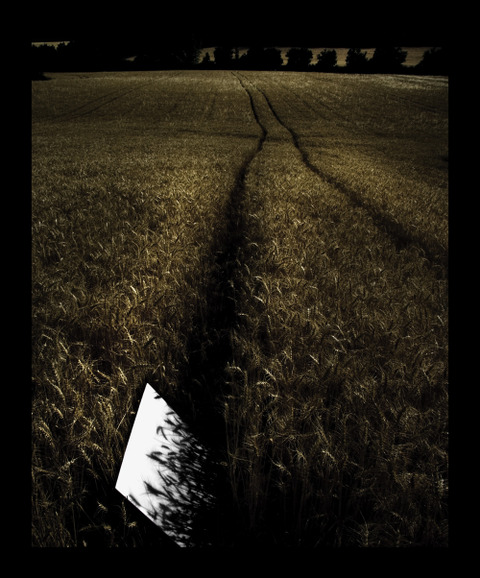
Sombras de Trigo, 2006
Manel Esclusa, with one of the most personal and recognizable iconographic universes among Spanish artists, began his La Sombra del Paisaje(The Shadow of the Landscape) series in 2006 and, as with several other of his works, returns to it sporadically, depending on his states of mind. Photographers often use landscape as a metaphorical territory, since both natural and urban landscapes are susceptible to becoming emotional scenes in which the photographer’s intimate universe is evident. It could be said that in Manel Esclusa’s photographs a movement of the original place - the photographed space - occurs, towards its conversion into a symbolic scene that shows the relationship of the author with nature and with his own photography: the images display a visual and conceptual structure that accommodates and configures the idea of their painter.This series is a convergence of some of the central elements of Esclusa’s relationship with photography, but it also emphasizes the pre-eminence of shadow as a leading element in his vast body of work. The shadow - a fragment of darkness - is converted by Esclusa into a ductile visual instrument that allows him to bring the physical world closer to his metaphysical thought. In La Sombra del Paisaje, he shows us some of the elements of his personal cosmogony, in which minimalism and subtle sediments of Zen philosophy can be seen through silent scenes; in these scenes, interventi-on by the photographer seems to limit itself to that of a mere intermediary, permitting nature to show, in an ephemeral instant, the mark of its majestic mundanity. Nonetheless, these photographs go beyond documentation or absence of intentionality: they are traces of light expanded into something approaching poetry, sublimations of that power of photography that allows it to make visible the invisible. Esclusa’s desire here is to construct an image of the world in which not his own presence but that of nature appears, thus paying tribute to the assertion of W. H. Fox Talbot, “nature draws itself”, contained in his pioneering book The Pencil of Nature. In that context, it could be said that these images are a metaphor for photography’s inaugural gesture: the photogram. Obviously, the images that emerge on the paper are also, besides being a homage to the photogram, a memory of the alchemical action that artificial light exerts on papers coated with emulsions of silver salts in a photographic laboratory. Both cases emphasize the passionate
relationship between the artist and photography, but also refer to the Corinthian legend about the mythical origin of painting: the capturing of the shadow of a human face projected onto a wall, which turns into a symbolic representation.
Nature, for Manel Esclusa, becomes a canvas onto which light does whimsical drawings. He merely selects a few fragments of those fleeting shadows in order to rescue them from invisibility, permitting them to exist, by means of vanishing luminescence on a white piece of paper that he situates amid the landscape in the form of an installation.
Deep down, many of Esclusa’s series came into being as the result of a process of profound interaction with the place in
which he is shooting. In order to create these images, the artist surrounds himself with solitude and silence: a setting
that helps introspection and accentuates his relationship, at once mystical and playful, with nature.
relationship between the artist and photography, but also refer to the Corinthian legend about the mythical origin of painting: the capturing of the shadow of a human face projected onto a wall, which turns into a symbolic representation.
Nature, for Manel Esclusa, becomes a canvas onto which light does whimsical drawings. He merely selects a few fragments of those fleeting shadows in order to rescue them from invisibility, permitting them to exist, by means of vanishing luminescence on a white piece of paper that he situates amid the landscape in the form of an installation.
Deep down, many of Esclusa’s series came into being as the result of a process of profound interaction with the place in
which he is shooting. In order to create these images, the artist surrounds himself with solitude and silence: a setting
that helps introspection and accentuates his relationship, at once mystical and playful, with nature.
text by Alejandro Castellote
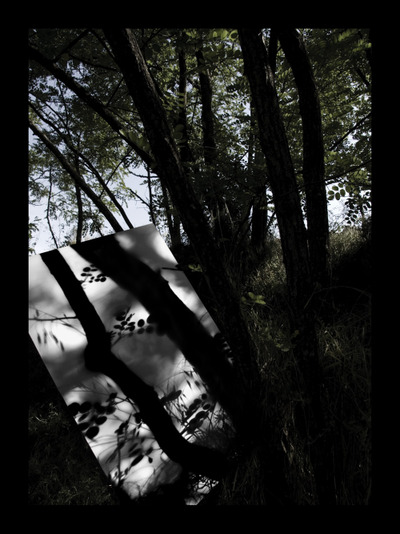
Sombra de Bosque, 2006

Sombra con Reflejo de Sombras, 2006
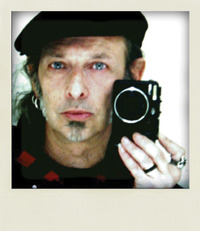
마넬 에스클루사
1952년 바르셀로나의 빅 출생으로, 현재 바르셀로나에서 거주하며 작업하고 있다. 아버지에게 배워 8세 때부터 사진을 시작했다. 빅 산업 대학원 석사 과정을 수학하였으며, 1966년부터 1972년까지 아버지와 함께 사진으로 일을 하였다. 1974년 카스텔바흐 예술 기금을 받아 아를에서 사진 인턴십 프로그램을 하며, 안셀 아담스, 닐 와이트, 루시앙 클레르그 등으로부터 사사를 받을 수 있었다. 전 세계적으로 활발한 전시 활동을 하고 있으며, 그의 작품은 세계 각지의 미술관과 컬렉션들에 소장되어 있다.
1952년 바르셀로나의 빅 출생으로, 현재 바르셀로나에서 거주하며 작업하고 있다. 아버지에게 배워 8세 때부터 사진을 시작했다. 빅 산업 대학원 석사 과정을 수학하였으며, 1966년부터 1972년까지 아버지와 함께 사진으로 일을 하였다. 1974년 카스텔바흐 예술 기금을 받아 아를에서 사진 인턴십 프로그램을 하며, 안셀 아담스, 닐 와이트, 루시앙 클레르그 등으로부터 사사를 받을 수 있었다. 전 세계적으로 활발한 전시 활동을 하고 있으며, 그의 작품은 세계 각지의 미술관과 컬렉션들에 소장되어 있다.
Manel EsclusaBorn in Vic, Barcelona, 1952. He lives and works in Barcelona. He started photography in his father’s studio at the age of eight. He studied at the Escola de Maestria Industrial in Vic. He worked with his father from 1966 to 1972. In 1974 he received a grant from the Castellbach Arts Endowment allowing him to attend the Stages Stages Internationaux de la Photographie in Arles, France, where he had the chance to form under the tutelage of Ansel Adams, Neal White, Arthur Trees, Ian Dieuzaide, Denis Briat and Lucien Clergue. He has had many international exhibitions and many of his works are part of international public and private collections.
No comments:
Post a Comment